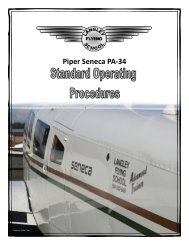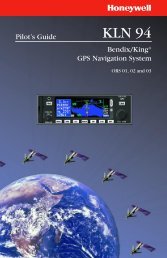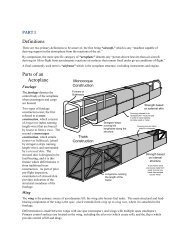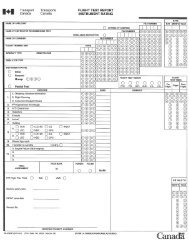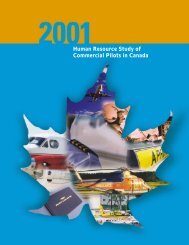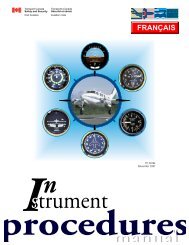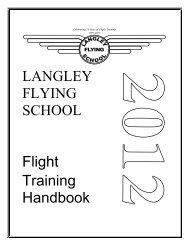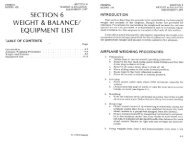Langley Flying School Private Pilot Groundschool Manual Sample ...
Langley Flying School Private Pilot Groundschool Manual Sample ...
Langley Flying School Private Pilot Groundschool Manual Sample ...
Create successful ePaper yourself
Turn your PDF publications into a flip-book with our unique Google optimized e-Paper software.
<strong>Private</strong> and Recreational <strong>Pilot</strong> <strong>Groundschool</strong> <strong>Manual</strong> Page 39<strong>Langley</strong> <strong>Flying</strong> <strong>School</strong>, Inc.CoolingMost general aviation engines are air-cooled, whereby ram air entersthe engine cowling from the front, and is circulated around the cylindersusing baffles; the baffles surround the cylinders in the form of a lightmetal box structure that controls and maximizes the movement of coolair.With higher performance aircraft that are more tightly cowled, thequantity of air moving through the baffles can be controlled by the pilotvia cowl flaps, which are like reverse air scoops; the cowl flaps areopened during taxiing or during climbs to increase the volume of airmovement, and are closed to reduce drag during the cruise phase.Engine heat from cylinders is dissipated by fins that form part of thecylinder outer wall.EngineCowlingCooling AirIntakecylinderheadBafflescylinderheadBafflesEngineCowling(open during taxiing,takeoff, and climbs)OilThere are four functions of engine oil: cooling, sealing (pistons), lubrication, flushing (cleaning).<strong>Pilot</strong> rule: Oil types cannot be mixed; for example, when oils contain additives (detergents and dispersants, etc.)only oil of the same type should be added.Oil is graded by viscosity (resistance to flow, stickiness); the higher the viscosity, the smaller are the changes in theviscosity of the oil owing to temperature changes.Three systems for grading viscosity are used:1. S.A.E. Number (Society of Automotive Engineers).2. Saybolt Universal Viscosity.3. US GradeThe formula to translate the oil grades: Saybolt Viscosity (100, for example) equals 2 times the S.A.E. number (50).The U.S. Grade is the Saybolt Viscosity plus 1000 (1100).The type of oil to be added to an aircraft can be determined by the pilot by reviewing preceding maintenance entriesin the aircraft Journey Log.Oil temperature should be regularly monitored in the cockpit, as an indication of engine health. The oil temperaturegauge probe is located where the oil enters the engine. If the oil gets too hot, viscosity is lost and engine parts losetheir protective film of oil; if the oil is too cold, the thick oil cannot flow through engine passageways, and oilfunctions are impaired.Oil pressure monitors pressure of oil supplied by the oil pump. It must be checked right after start, 22 and duringoperations. 23Oil pressure and temperature gauges provide redundancy and a means of verifying engine trouble; a loss of oilpressure on the gauge may indicate engine trouble but it may also indicate an erred reading on the instrument itself;but a loss of pressure indication, combined with an increased temperature indication means a forced landing isimminent.There are two types of oil systems: Wet Sump—oil supply kept in sump or pan under crank case—and Dry Sump—oil supply contained in separate tank (aerobatic aircraft).22 Oil pressure should be indicated in the green arch of the gauge within 30 seconds of engine start, and if not the engine should be shut down andthe problem investigated.23 There are several causes that could be associated with low oil pressure during flight, but the most common are insufficient oil quantity,excessive blow-by of oil past the piston rings, oil leaks, clogged oil-pressure relief valve, or excessively high oil temperature; high oil pressureindications during flight are likely caused by inaccurate instrument indications. Generally, aircraft engines can continue to develop oil pressurewith as little as two or three quarts.© 2012 David L. Parry



